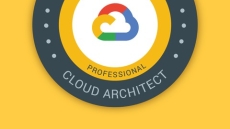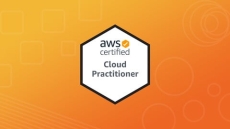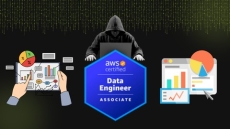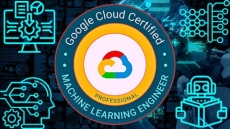Well performing AWS practitioners have great long-term job oppertunities. Each higher level of AWS certification brings a higher standard of benchmarking skill and ability, which leads to greater opportunities and higher pay.
What people say who are certified by AWS:
- 93 percent received up to a 25 percent salary increase after obtaining certification
- 85 percent of learners say they retain more of what they’re learning by doing
- 73 of our learners report improved job performance
- 50 percent of those who obtained certifications experienced a career benefit within two months
Benefeits of getting further certified:
- Added credibility
- Good job opportunities
- AWS Experts are in Demand
- AWS dominates the market with 33.8 percent global market share
Exam Concepts:
- Domain 1: Cloud Concepts (26%)
- Domain 2: Security and Compliance (25%)
- Domain 3: Technology (33%)
- Domain 4: Billing and Pricing (16%)
This course provide overall 545 unique questions for your exam preparation. There are no duplicated questions. All questions are multiple choice with one or several correct answer. You will get the information of how many answers are correct for each question as in the real exam.
There are 5 test exams for you. Each has 60 questions as the real exam has.
There sixth exam test contains 240 questions. You should do this test, after solving the first 5 tests with a very good score
You will learn about the following contents as they can be covered by the exam:
Exam Topics
Domain 1: Cloud Concepts
- 1.1 Define the AWS Cloud and its value proposition
- Define the benefits of the AWS cloud including:
- Security
- Reliability
- High Availability
- Elasticity
- Agility
- Pay-as-you go pricing
- Scalability
- Global Reach
- Economy of scale
- Explain how the AWS cloud allows users to focus on business value
- Shifting technical resources to revenue-generating activities as opposed to managing infrastructure
- Define the benefits of the AWS cloud including:
- 1.2 Identify aspects of AWS Cloud economics
- Define items that would be part of a Total Cost of Ownership proposal
- Understand the role of operational expenses (OpEx)
- Understand the role of capital expenses (CapEx)
- Understand labor costs associated with on-premises operations
- Understand the impact of software licensing costs when moving to the cloud
- Identify which operations will reduce costs by moving to the cloud
- Right-sized infrastructure
- Benefits of automation
- Reduce compliance scope (for example, reporting)
- Managed services (for example, RDS, ECS, EKS, DynamoDB)
- Define items that would be part of a Total Cost of Ownership proposal
- 1.3 Explain the different cloud architecture design principles
- Explain the design principles
- Design for failure
- Decouple components versus monolithic architecture
- Implement elasticity in the cloud versus on-premises
- Think parallel Version
- Explain the design principles
Domain 2: Security and Compliance
- 2.1 Define the AWS shared responsibility model
- Recognize the elements of the Shared Responsibility Model
- Describe the customer’s responsibly on AWS
- Describe how the customer’s responsibilities may shift depending on the service used (for example with RDS, Lambda, or EC2)
- Describe AWS responsibilities
- 2.2 Define AWS Cloud security and compliance concepts
- Identify where to find AWS compliance information
- Locations of lists of recognized available compliance controls (for example, HIPPA, SOCs)
- Recognize that compliance requirements vary among AWS services
- At a high level, describe how customers achieve compliance on AWS
- Identify different encryption options on AWS (for example, In transit, At rest)
- Describe who enables encryption on AWS for a given service
- Recognize there are services that will aid in auditing and reporting
- Recognize that logs exist for auditing and monitoring (do not have to understand the logs)
- Define Amazon CloudWatch, AWS Config, and AWS CloudTrail
- Explain the concept of least privileged access
- Identify where to find AWS compliance information
- 2.3 Identify AWS access management capabilities
- Understand the purpose of User and Identity Management
- Access keys and password policies (rotation, complexity)
- Multi-Factor Authentication (MFA)
- AWS Identity and Access Management (IAM)
- Groups/users
- Roles
- Policies, managed policies compared to custom policies
- Tasks that require use of root accounts Protection of root accounts
- Understand the purpose of User and Identity Management
- 2.4 Identify resources for security support
- Recognize there are different network security capabilities
- Native AWS services (for example, security groups, Network ACLs, AWS WAF)
- 3rd party security products from the AWS Marketplace
- Recognize there is documentation and where to find it (for example, best practices, whitepapers, official documents)
- AWS Knowledge Center, Security Center, security forum, and security blogs
- Partner Systems Integrators
- Know that security checks are a component of AWS Trusted Advisor Version
- Recognize there are different network security capabilities
Domain 3: Technology
- 3.1 Define methods of deploying and operating in the AWS Cloud
- Identify at a high level different ways of provisioning and operating in the AWS cloud
- Programmatic access, APIs, SDKs, AWS Management Console, CLI, Infrastructure as Code
- Identify different types of cloud deployment models
- All in with cloud/cloud native o Hybrid
- On-premises
- Identify connectivity options
- VPN
- AWS Direct Connect
- Public internet
- Identify at a high level different ways of provisioning and operating in the AWS cloud
- 3.2 Define the AWS global infrastructure
- Describe the relationships among Regions, Availability Zones, and Edge Locations
- Describe how to achieve high availability through the use of multiple Availability Zones
- Recall that high availability is achieved by using multiple Availability Zones
- Recognize that Availability Zones do not share single points of failure
- Describe when to consider the use of multiple AWS Regions
- Disaster recovery/business continuity
- Low latency for end-users
- Data sovereignty
- Describe at a high level the benefits of Edge Locations
- Amazon CloudFront
- AWS Global Accelerator
- 3.3 Identify the core AWS services
- Describe the categories of services on AWS (compute, storage, network, database)
- Identify AWS compute services
- Recognize there are different compute families
- Recognize the different services that provide compute (for example, AWS Lambda compared to Amazon Elastic Container Service (Amazon ECS), or Amazon EC2, etc.)
- Recognize that elasticity is achieved through Auto Scaling
- Identify the purpose of load balancers
- Identify different AWS storage services
- Describe Amazon S3
- Describe Amazon Elastic Block Store (Amazon EBS)
- Describe Amazon S3 Glacier o Describe AWS Snowball
- Describe Amazon Elastic File System (Amazon EFS)
- Describe AWS Storage Gateway
- Identify AWS networking services
- Identify VPC
- Identify security groups o Identify the purpose of Amazon Route 53
- Identify VPN, AWS Direct Connect
- Identify different AWS database services
- Install databases on Amazon EC2 compared to AWS managed databases Version
- Identify Amazon RDS
- Identify Amazon DynamoDB
- Identify Amazon Redshift
- 3.4 Identify resources for technology support
- Recognize there is documentation (best practices, whitepapers, AWS Knowledge Center, forums, blogs)
- Identify the various levels and scope of AWS support
- AWS Abuse o AWS support cases
- Premium support
- Technical Account Managers
- Recognize there is a partner network (marketplace, third-party) including Independent Software Vendors and System Integrators
- Identify sources of AWS technical assistance and knowledge including professional services, solution architects, training and certification, and the Amazon Partner Network
- Identify the benefits of using AWS Trusted Advisor
Domain 4: Billing and Pricing
- 4.1 Compare and contrast the various pricing models for AWS (for example, On-Demand Instances, Reserved Instances, and Spot Instance pricing)
- Identify scenarios/best fit for On-Demand Instance pricing
- Identify scenarios/best fit for Reserved-Instance pricing
- Describe Reserved-Instances flexibility
- Describe Reserved-Instances behavior in AWS Organizations
- Identify scenarios/best fit for Spot Instance pricing
- 4.2 Recognize the various account structures in relation to AWS billing and pricing
- Recognize that consolidated billing is a feature of AWS Organizations
- Identify how multiple accounts aid in allocating costs across departments
- 4.3 Identify resources available for billing support
- Identify ways to get billing support and information
- Cost Explorer, AWS Cost and Usage Report, Amazon QuickSight, third-party partners, and AWS Marketplace tools
- Open a billing support case
- The role of the Concierge for AWS Enterprise Support Plan customers
- Identify where to find pricing information on AWS services
- AWS Simple Monthly Calculator
- AWS Services product pages
- AWS Pricing API
- Recognize that alarms/alerts exist
- Identify how tags are used in cost allocation
- Identify ways to get billing support and information
In case you have questions, do not hesitate to contact us.
Please be aware that we are working on this course on an ongoing basis. We always want to deliver highest quality to you and we try our best to do so. If you find any issue let us know and we will correct it immediatelly 🙂
Who this course is for:
- AWS Clud Practitioner CLF-C01
- AWS
- Cloud Practitioner
- Cloud Experts
- CLF-C01
- Exam preparation
- certification
How to Enroll AWS Certified Cloud Practitioner – Full Exam Preparation course?
How many members can access this course with a coupon?
AWS Certified Cloud Practitioner – Full Exam Preparation Course coupon is limited to the first 1,000 enrollments. Click 'Enroll Now' to secure your spot and dive into this course on Udemy before it reaches its enrollment limits!









